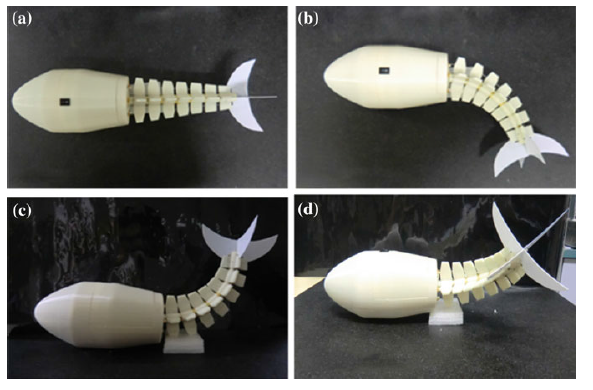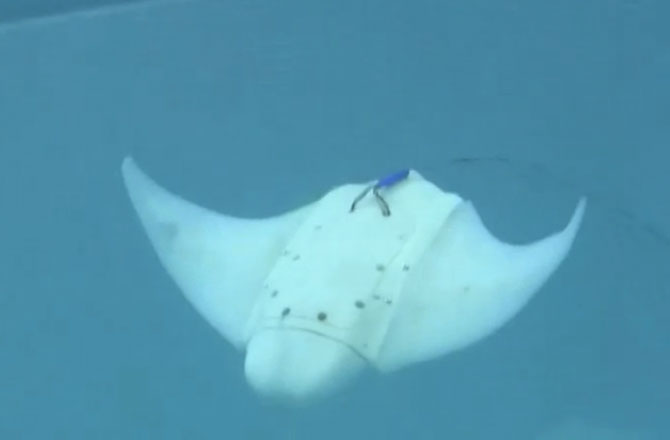Introduction
Exploration of the oceans is not a simple task, requiring specialized technology. One such technology is AUVs, or Autonomous Underwater Vehicles which are “robotic vehicles that, depending on their design, can drift, drive, or glide through the ocean without real-time control by human operators”. AUVs have been built and programmed to perform a wide range of tasks, from mapping the ocean floor to monitoring environmental conditions. A variety of sensors can be used to gather data about different aspects of the environment. Control systems can also be employed to allow intelligent movement by an AUV so it can actively explore the area to which it travels.
Much of technology draws inspiration from nature, so much so that we have a term for it. Biomimetics, or biomimicry, is “the study and development of synthetic systems that mimic the formation, function, or structure of...biological mechanisms and processes”. Mimicking biology, especially in the case of animals, is beneficial particularly in the cases where the animal performs better than existing technology. For instance, inspiration was taken from a gecko to create RiSE, a robot that can climb vertical surfaces. Previously, navigating vertical terrain would have been very difficult.
There are some instances where inspiration from biology has been applied specifically to AUVs. For example, several types of robotic fish have been created focusing on mimicking different characteristics of movement. Tested motion patterns include lateral movement, complex movement of pectoral fins, tail motion, and other naturally adaptive processes that could be beneficial to an operating AUV. The mechanical movement is important, but it also needs to be controlled properly. In order to behave like a fish, the control systems should be able to adapt to changing environmental conditions based on input from the sensor systems. This could also contribute to the goal of navigation over a longer distance. Another reason for exploring a biomimetic model is the potential for reduced energy cost at a comparable performance level. Fish can have a propulsion efficiency of up to 90%, while typical rotary propellers have about half of that.
The project evaluated several actuation methods with respect to their use in biomimicry. Throughout several cycles of manufacturing, analysis, and revision, a soft robotic fin and the process for fabricating it were developed. An on-board power supply and microcontroller allowed the robot to operate untethered. Essential sensors provided feedback necessary for intelligent actuation.
This report discusses a basic background of Autonomous Underwater Vehicles and introduces some similar projects. Next, the progress and methodology of the project are described, including research, prototyping, manufacturing and testing. Lastly, results of the project are presented and areas for future work are suggested.

Robotic Fish Mimicking Dolphin and Shark Movement
Background
History of AUVs
A major limiting factor to current AUVs is propulsion and energy efficiency. With the energy density of currently available power storage systems, AUVs are limited in their operating time. While gliders and floats generally require very little power to operate, these methods are not suitable when a higher degree of maneuverability is required. The most common alternative is the screw propeller found in many boats. MIT’s maneuverable underwater vehicle Rex II, for example, is capable of fine motor control but is limited to 8 hours of operating time or 15 km while their Odyssey IV is capable of roughly 11 hours or 80 km. Both of these vehicles utilize screw propeller propulsion.
There are some forms of underwater vehicles that can operate for long periods of time usually gathering data in various oceans at the cost of control and accuracy in its travel. For instance, sea gliders use changes in buoyancy to roughly control their trajectory in the water. This saves power, but as a result, the end destination can be difficult to calculate.
Another example of long term sea vehicles is Argo floats. These floats can stay in the water for over four years, gathering data and relaying it through satellites. The tradeoff of staying in the water so long is that they cannot be steered or navigated other than following the currents. They only adjust their buoyancy to gather data from deeper in the ocean and to reach the surface to relay their information. These floats are ideal for mapping information about the ocean on a global scale, but they are not designed for gathering details for a specific area.
Biomimetics
In addition to the propulsion, other capabilities seen in nature can be applied to a bio-inspired underwater robot. For instance, quiet movement and maneuverability would allow for exploration into sensitive environments and areas that are difficult to navigate with traditional AUVs. A vehicle that resembled an actual sea creature could be helpful in examining an environment without disturbing the existing wildlife.
There have been significant advances in artificial muscles and other actuation technologies. The potential advantages and disadvantages of the most promising biomimetic actuation methods were considered as shown in section 3.2: Actuation Comparison.
Similar Projects
This project is not the first of its kind. There have been numerous research studies into the movement of various rays and their efficiency. Additionally, there have been a number of notable manta ray robots. The most well-known being the Festo Aqua Ray, a small robot aiming to show off Festo's new actuators, allowing for no payload and with minimal information published on efficiency and cost.12 The second notable project was a joint venture with the University of Virginia and the Department of the Navy. Although this robot is an amazing advancement, it relies on rigid structures, is not autonomous, and has poor energy efficiency. Additionally, the soft robotic fish from WPI used sections of channels set into silicone that expand and bend when filled with a fluid. The result was a high degree of natural articulation. However they chose to use compressed air, which cannot be recompressed without significant power onboard, requiring air in the system be expelled to the outside water. This, in turn, gave the robot a limited finite operating capacity, as the number of actuations was limited by the amount of compressed air carried onboard.

Bio-inspired Mantabot from University of Virginia
Project Goals
In order to create an AUV that has combined maneuverability and efficiency, it was decided to base the robot on the manta ray. Manta rays’ oscillating propulsion allows for a reasonable degree of control while requiring less energy consumption than traditional methods. Additionally, their wide thin shape allows them to glide through the water while traveling over longer distances.
Goals were prioritize into a three tiered system. Tier 1 consisted of goals which the device needed to achieve in order to be considered a robot and for the project to be considered a success. This included autonomy so the robot could move on its own, untethered, to perform a pre-programmed mission. Another main goal was the oscillatory movement of the fins, out of the water, reminiscent of the movement performed by a manta ray.
Tier 2 goals were important to the development of the robot, but were not all required for the success of this iteration of the project. They were mainly focused on having the robot perform in the water. For instance waterproofing is necessary for it to operate as an underwater vehicle. Buoyancy control would allow the robot to dive and surface while directional control would allow it to turn as desired. To further mimic a manta ray, considerable speed and efficiency were desired when operating in the water. A fail safe system would prevent extensive damage or loss of components in the event of a malfunction and a ping signal for recovery would simulate ability to locate the robot as if from a long mission.
Tier 3 goals were stretch goals known to be unlikely to be completed in full by this year’s team. Instead, they point to future areas of interest that could further develop the result from this year’s project. A more comprehensive surface location capability would allow for the robot to be tracked on the surface from a significant distance for recovery. Depth hardening would allow deeper parts of the ocean to be explored, and navigation under the surface would mean autonomous missions could be more effective. Lastly, 100% natural movement that biologically mimics a manta ray would create a robot of even greater speed and efficiency.
Tier 1 | Tier 2 | Tier 3 |
Basic Oscillatory Motion | Watertight | Surface Location Capabilities for Recovery |
Untethered | Buoyancy Control | Depth Hardening |
Fully Autonomous | Directional Control | Navigation |
Environmentally Safe | Efficiency and Speed in Water | 100% Natural Movement |
| Fail Safe System |
|
| Ping Signal for Recovery |
|
